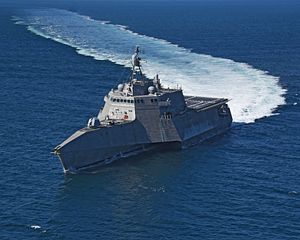The U.S. Navy has deployed two Independence-class littoral combat ships (LCS) to the South China Sea earlier this month, bolstering the U.S. military’s presence in the contested waters.
The service dispatched the USS Gabrielle Giffords from Changi naval base in Singapore to the South China Sea on November 15, while the USS Montgomery and warships of the Royal Australian Navy (RAN) conducted operations together in the waters between November 6 and 12.
“Gabrielle Giffords is on a rotational deployment to INDOPACOM [Indo-Pacific Command], conducting operations, exercises and port visits throughout the region and working hull-to-hull with allied and partner navies to provide maritime security and stability, key pillars of a free and open Indo-Pacific,” the U.S. Navy said in a statement.
Pictures of the Gabrielle Giffords show the LCS sailing through the South China Sea on November 18. The trimaran deployed to the Indo-Pacific region on September 3 from its homeport in San Diego, California.
In June, the U.S. Navy, for the first time after a 19-months lapse in deployments, dispatched the USS Montgomery to Asian waters.
The USS Montgomery conducted a bilateral exercise with the RAN’s Anzac-class frigate HMAS Stuart and fleet replenishment vessel HMAS Sirius between November 6 and 12.
“While transiting together at sea, Montgomery, Stuart and Sirius conducted communication drills, division tactics, bilateral flight operations, and a personnel exchange, all designed to address common maritime security priorities, enhance interoperability, and develop relationships that will benefit both navies for many years to come,” according to the U.S. Navy.
“Also accomplished were two replenishments at sea (RAS) with Sirius, marking the first time an LCS has received fuel from an allied navy vessel while underway.”
The USS Gabrielle Giffords is the first LCS to carry the fifth-generation over-the-horizon Naval Strike Missile (NSM). While each LCS can be armed with up to eight missiles following a retrofit, the Navy has not officially revealed how many NSMs the USS Gabrielle Giffords is carrying for the duration of its deployment. According to media reports, the ship carries all eight NSMs in box launchers.
“The missile, featuring an imaging IR-seeker and inertial/GPS navigation, can strike both sea and land targets at a distance of around 185 kilometers (100 nautical miles),” I wrote previously. “Carrying a 125-kilogram (276 pounds) multi-purpose blast/fragmentation warhead, the NSM is capable of reaching high subsonic speeds and can approach its targets in sea skim mode.”
The NSM is linked with a MQ-8B Fire Scout helicopter drone used for scouting over-the-horizon targets.
The USS Gabrielle Giffords fired a NSM at a target ship (the ex-USS Ford) during a joint naval exercise with the Republic of Singapore Navy off the coast of Guam on October 1.
Not a single LCS deployed in all of last year. The last LCS to deploy to the region was the Independence-class USS Coronado in October 2016.
Update: According to media reports, the USS Gabrielle Giffords conducted a“freedom of navigation operation” (FONOP) near Mischief Reef in the South China Sea on November 20.

































